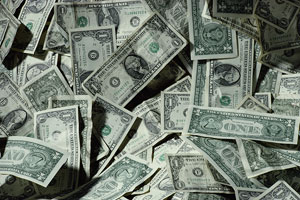TIM PARADIS
NEW YORK
Wall Street extended its gains to a second day Wednesday as investors grew more optimistic that an expected interest rate cut will indeed help move the economy toward recovery.
With the Federal Reserve winding down a two-day meeting on interest rates, the market expects policymakers to lower the fed funds rate, which stands at 1.5 percent, by a half point or three-quarters of a point, though there has been speculation about smaller or larger cuts. The decision is due at 2:15 p.m. EDT.
Wall Street also will pore over the Fed’s statement on its decision for its reading of the economy. That assessment, along with any move on the fed funds rate itself, could lead the market to retreat, rally or simply shrug off a development that it writes off as expected.
Dan Genter, president and chief investment officer of RNC Genter in Los Angeles, said some of the buying ahead of the Fed’s rate decision reflects an uptick of optimism in the market.
“It’s going to make people feel stronger that the Fed is taking that kind of action,” he said of a possible rate cut, even one that is widely expected.
Genter said the market appears to be benefiting from a break in the selling by hedge funds and mutual funds that has occurred as some investors exited the market and also at the behest of brokers who can force professional investors to set aside larger cash cushions as stocks lose value.
“As long as you can get a day where you can take a breath and you just don’t have huge redemptions that are taking place then there is some money out there,” he said.
Stocks began the session with modest fluctuations but then saw larger advances that added to the 889-point surge logged by the Dow Jones industrials Tuesday. The Dow and the Standard & Poor’s 500 index posted gains of nearly 11 percent, while the Nasdaq composite index rose 9.5 percent as investors, confident about the prospects for a rate cut, piled into the market to pick up stocks that have become bargains.
The Dow’s gain was its second-largest daily point gain; the biggest was its 936-point surge on Oct. 13 that later evaporated as fears about the economy grew. The stock market has been extremely volatile lately – beyond a simple case of investor indecision, Wall Street’s back-and-forth moves may also be part of its attempt to establish a bottom.
In midafternoon trading shortly before the expected release of the Fed’s statement, the Dow rose 124.73, or 1.38 percent, to 9,189.85 after falling in earlier trading.
Broader stock indicators also advanced. The S&P 500 index rose 12.41, or 1.32 percent, to 952.92, and the Nasdaq composite index rose 25.79, or 1.56 percent, to 1,575.26.
The Russell 2000 index of smaller companies rose 10.52, or 2.18 percent, to 493.07.
Advancers outnumbered decliners by about 2 to 1 on moderate volume of 747.2 million shares on the New York Stock Exchange.
The dollar weakened ahead of a possible rate cut. That slide helped drive commodity prices higher, as many are priced in dollars. Light, sweet crude rose $4.82 to $67.65 a barrel on the New York Mercantile Exchange.
“What we’re doing today is waiting,” said David Reilly, director of portfolio strategy at Rydex Investments. He contends the market likely won’t react wildly if the Fed’s move largely meets expectations but said a smaller rate cut could alarm Wall Street.
“Anything less than a 50 basis point (0.5 percentage point) cut I think would be nothing short of calamitous,” Reilly said.
A surprise gain in orders for big-ticket manufactured goods did little to galvanize the market early in the session. The Commerce Department said orders for durable goods – items such as cars, appliances and machinery expected to last at least three years – rose 0.8 percent in September after tumbling 5.5 percent in August. Orders were expected to have fallen by 1.5 percent.
The rebound in durable goods was welcome news, though not enough to erase Wall Street’s concerns about the economy.
The three major stock indexes are still down more than 30 percent for the year, battered since last month’s freeze-up of the credit markets. The troubles with the credit markets have made it harder and more expensive for businesses and consumers to get loans.
Moves by hedge funds and mutual funds to exit positions have added to the market’s volatility, analysts say, adding that the market likely won’t have a sustained recovery until some big players halt more of their selling.
While signs have emerged that the government action to revive credit markets is starting to work, investors remain skittish over the effects of the prolonged credit freeze on the economy, which relies on lending to feed growth.
Investors are hoping a rate cut by the Fed would complement the government’s still-unfolding efforts to aid the commercial paper market, where companies turn for short-term loans, and the banks themselves. The Treasury this week is investing directly in banks, hoping the cash will make them more likely to issue loans.
Meanwhile, investors examined demand for government debt. The yield on the three-month Treasury bill, regarded as the safest investment around and an indicator of investor sentiment, fell to 0.61 percent from 0.74 percent Tuesday. A drop in yield indicates an increase in demand. Meanwhile, the yield on the benchmark 10-year Treasury note fell to 3.81 percent from 3.84 percent late Tuesday.
Wall Street’s rally Tuesday helped lift trading in most markets overseas. Japan’s Nikkei stock average jumped 7.74 percent. Britain’s FTSE 100 rose 8.05 percent, Germany’s DAX index slipped 0.31 percent, and France’s CAC-40 rose 9.23 percent.










